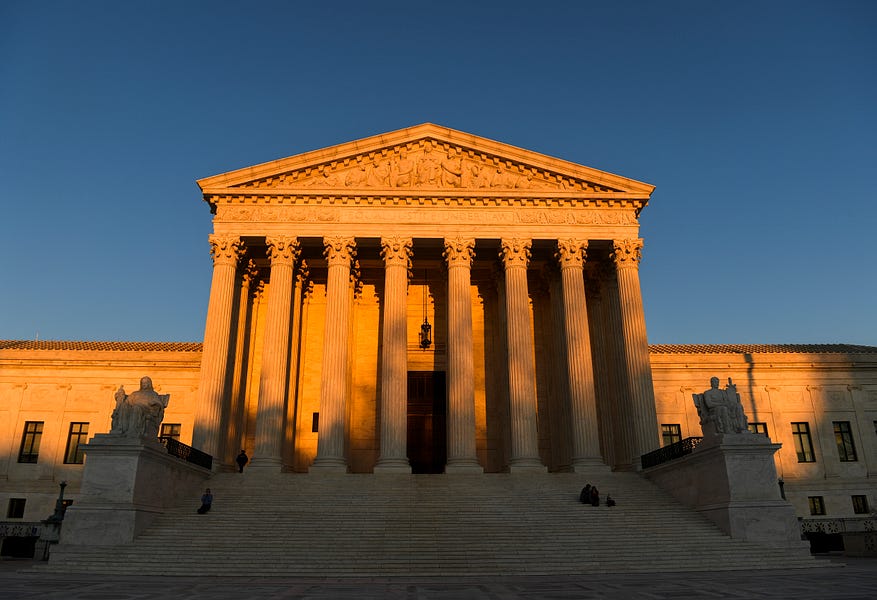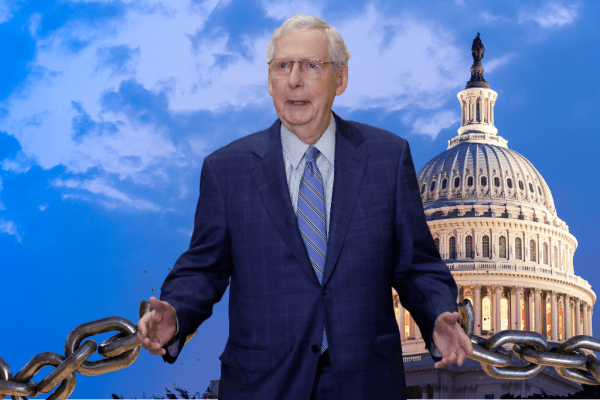In a month that included major Supreme Court decisions on abortion, religious liberty, and the DACA program, the court’s most significant opinion could end up being Seila Law LLC v. Consumer Financial Protection Bureau. It might one day be recognized as the landmark case that halted, and even reversed, the decades-long growth of the administrative state.
The slippery slope.
Seila Law’s significance is tied to Humphrey’s Executor v. United States, a similarly mundane 1935 Supreme Court decision whose enormous impact was not immediately apparent. In 1933, President Franklin D. Roosevelt fired William Humphrey, a Coolidge appointee to the Federal Trade Commission. Humphrey sued, claiming the FTC Act specified that FTC commissioners could be removed by the president only “for cause”—“inefficiency, neglect of duty, or malfeasance in office”—which FDR had not provided (Humphrey died in 1934, before the court ruled).
Roosevelt pointed to Meyers v. United States, a 1926 Supreme Court decision that prohibited legal limitations on the president’s ability to fire government officials because such restrictions impermissibly interfered with the chief executive’s constitutional duty to supervise the executive branch. The Republican-leaning Humphrey’s court, in an attempt to rein in Roosevelt, circumvented the Meyers precedent by labeling the FTC’s functions “quasi-judicial” and “quasi-legislative” (rather than executive). Based on that dubious characterization, the court allowed the “for cause” removal limitation for FTC commissioners: Multi-member “expert” agencies like the FTC could be “independent” from the president without violating the Constitution.
Ironically, Roosevelt won big by losing. Humphrey’s seemingly innocuous exception to the Constitution’s separation of powers between the legislative, executive, and judicial branches was a classic slippery slope.
During the ensuing decades, Roosevelt and other proponents of large government bureaucracies—mostly Democrats—built increasingly larger and more powerful “independent” federal agencies. Many of these departed from the FTC’s bipartisan commission structure; some were tasked with clearly executive (as well as legislative and judicial) functions. Each exploitation of the loophole normalized the weakened separation of powers. The misguided Humphrey’s decision enabled the growth of an unofficial fourth branch of government run by unelected, difficult-to-fire bureaucrats—the administrative state.
Still, only once before Seila Law had the Supreme Court explicitly sanctioned for-cause tenure protection in a single-headed agency with significant executive functions. In the 1988 Morrison v. Olson decision, the court upheld “for cause” protection for the independent counsel by creating a second exception to Meyers for an “inferior officer … with limited jurisdiction … and lacking policymaking or significant administrative authority.”
The reasoning of Justice Scalia’s brilliant lone dissent in Morrison has since been adopted by most conservative jurists, including the five current Republican-appointed Supreme Court justices. Scalia noted that the maxim “the United States is a government of laws, and not of men,” which was famously used by Chief Justice Marshall in his foundational Marbury v. Madison opinion, is actually a quote from the Massachusetts Constitution’s separation of powers clause. Furthermore, Scalia continued, while “the separation of powers may prevent us from righting every wrong, it does so in order to ensure that we do not lose liberty.” Unlike other disputes, in separation of powers cases that involve the legislative branch encroaching on the executive branch, the Supreme Court does not afford the usual “great deference to Congress’ view that what it has done is constitutional.”
The Democrats’s Golem.
In 2008, voters reeling from the mortgage-induced financial crisis elected a Democratic president and overwhelming Democratic majorities in both the Senate and House of Representatives. Freed from meaningful Republican opposition, their 2010 Dodd-Frank Act created the CFPB to enforce 19 financial laws and regulate almost every consumer financial product, including credit cards, mortgages, debt collection, payday loans, and credit reporting. The CFPB was its own self-contained three-branch government—it issued financial industry rules (legislative), investigated legal violations that carried enormous penalties (executive), and tried defendants who refused to pay them in its own administrative court (judicial).
The CFPB would be led by a single director who, after Senate confirmation to a five-year term, could be removed by the president only for cause (potentially preventing a one-term president from ever appointing a CFPB director). Furthermore, the agency was guaranteed funding through the Federal Reserve Bank (rather than tax revenue), which shielded the CFPB from meaningful legislative oversight by eliminating the threat of congressional budget cuts. Such monsters rarely dwell outside totalitarian states.
The super-independent golem was unlikely to turn against its creators. By choosing the CFPB’s first director and controlling its initial hiring, Democrats could entrench a liberal bureaucratic culture in the agency. Furthermore, a future Republican-led CFPB might be less aggressive in protecting consumers, but it could not really harm them.
Nobody benefited more from the new agency than Elizabeth Warren, who had proposed a similar regulatory agency as a law professor in 2007, and later supervised the CFPB’s yearlong start-up as a presidential adviser in 2010-11. She staffed the agency’s huge External Affairs Division with political operatives, and then rode their nonstop publicity to election as a Massachusetts senator in 2012.
Warren’s handpicked enforcement chief, Richard Cordray, became the CFPB’s first director, and quickly proved that the risk of government oppression increases as government officials become more independent. Under Cordray’s leadership, the CFPB investigated and prosecuted financial businesses based on size rather than culpability (many were innocent ), deprived them of due process and a meaningful opportunity to defend themselves, imposed jaw-dropping fines according to defendants’ ability to pay rather than any harm they’d done to consumers, furtively diverted millions of the collected penalty dollars to Democratic-favored organizations (rather than consumers), and stonewalled congressional oversight.
A close call.
When the Supreme Court, in its Seila Law decision, finally ruled that the CFPB director’s “for cause” tenure protection was an unconstitutional but severable provision in the Dodd-Frank Act, many in the media shrugged it off as an anti-climactic legal tweak. But Seila Law was no more about the structure of Warren’s pet agency than Humphrey’s was about a dead man’s wages.
Chief Justice Roberts’s 5-4 majority opinion began with a clear exposition of the Constitution’s removal power that echoed Scalia’s Morrison dissent: The Framers deliberately protected the chief executive’s authority from legislative interference (laws that impede the president’s “decisions, activities, secrecy, and dispatch in performing his duties”); their sole check on the president was regular elections by every United States citizen (unique to the president and vice-president); voters cannot hold the president accountable for the performance of government officials he cannot fire, so the Constitution’s vesting of the executive power in the president included the removal power. Roberts’s simple, unequivocal pronouncement strengthened Meyers and weakened Humphrey’s: “the President’s removal power is the rule, not the exception.”
Justice Elena Kagan’s Seila Law dissent reveals just how much damage a win for the CFPB would have done to the Constitution’s separation of powers. The threat was very real—her reasoning was nearly identical to that of every Democratic-appointed 9th Circuit Court of Appeals and D.C. Circuit Court of Appeals judge who previously had ruled on the CFPB’s structure.
Kagan opined that “the separation of powers is, by design, neither rigid nor complete,” and mocked Roberts for offering “the civics class version of separation of powers—call it the Schoolhouse Rock definition of the phrase.” She interpreted the Constitution to bestow “discretion on the legislature to structure administrative institutions as the times demand,” and give “Congress wide leeway to limit the President’s removal power” to “enhance independence from politics in regulatory bodies.” Kagan then listed piecemeal similarities between the CFPB and various independent agencies, and found the CFPB’s structure to be nothing special.
Roberts dismissed Kagan’s analysis as “ignoring the reasoning of Humphrey’s and instead applying the decision only as part of a reimagined Humphrey’s-through-Morrison framework.” But rather than reverse Humphrey’s, the chief justice limited it and Morrison to two narrow exceptions to Meyers’s ban on laws impeding the president’s removal power:
-
multi-member expert agencies that do not wield substantial executive power (as the Humphrey’s court dubiously characterized the 1935 FTC); and
-
inferior officers with limited duties and no policymaking or administrative authority (Morrison’s independent counsel).
Since the CFPB fit neither exception, Roberts could decide Seila Law without revisiting the Humphrey’s and Morrison precedents. He fixed the agency’s constitutional flaw by removing the “for cause” limitation on the president’s ability to fire the CFPB director.
Warren’s tweets following the decision were comical. First she downplayed its impact (“Even after today’s ruling, the @CFPB is still an independent agency”), and then she bemoaned the agency’s lost independence (“the Supreme Court … just handed over more power to Wall Street’s army of lawyers and lobbyists to push out a director who fights for the American people.”). Go figure.
Conservatives criticized Roberts for not going far enough. Justice Thomas, in a powerful concurring opinion joined by Justice Gorsuch, noted that “it is not clear what is left of Humphrey’s rationale. …Today, the Court does enough to resolve this case, but in the future, we should reconsider Humphrey’s in toto. And I hope that we will have the will to do so.”
Roberts’s restraint was a calculated gamble that the court would soon have another shot at Humphrey’s. By emphasizing its flawed premise that the FTC did not exercise executive power, he practically begged for constitutional challenges to the FTC and other independent commissions like the SEC and FCC. Plus, his mention of the “ongoing controversy” over the single-director structure of the Federal Housing Finance Agency, “essentially a companion of the CFPB,” left little doubt about the outcome of an upcoming challenge to the FHFA’s structure.
Overturning Humphrey’s now would have sent shock waves through much of the federal government months before an election that could hand Democrats a 2009-like majority, which would allow them to expand the size of the Supreme Court and pack it with liberal justices. To the incrementalist Roberts, that was an unnecessary risk—he was content to send Humphrey’s all the way back to 1935 and save America from a frightening new evolution of the administrative state. It was not what conservatives wanted, but it was what America needed.
Ronald L. Rubin was an enforcement attorney at the Consumer Financial Protection Bureau and chief adviser on regulatory policy at the House Financial Services Committee.
Photo by Jonathan Newton /Washington Post/Getty Images.






Please note that we at The Dispatch hold ourselves, our work, and our commenters to a higher standard than other places on the internet. We welcome comments that foster genuine debate or discussion—including comments critical of us or our work—but responses that include ad hominem attacks on fellow Dispatch members or are intended to stoke fear and anger may be moderated.
You are currently using a limited time guest pass and do not have access to commenting. Consider subscribing to join the conversation.
With your membership, you only have the ability to comment on The Morning Dispatch articles. Consider upgrading to join the conversation everywhere.